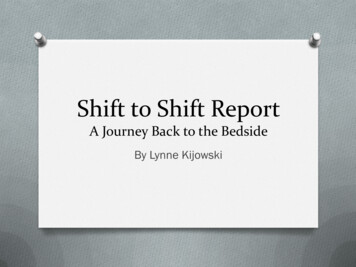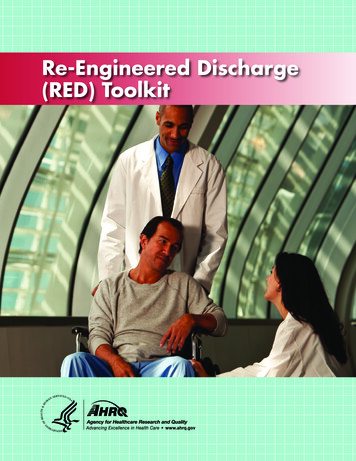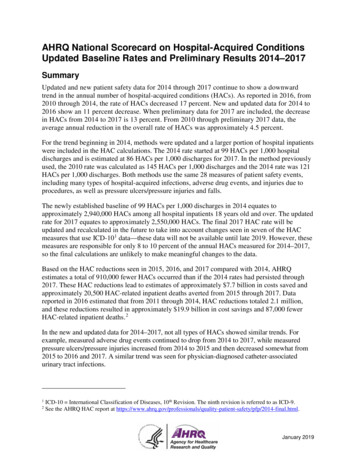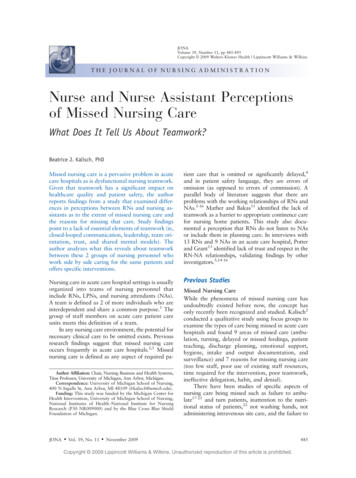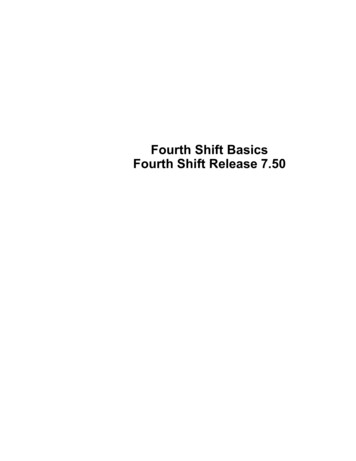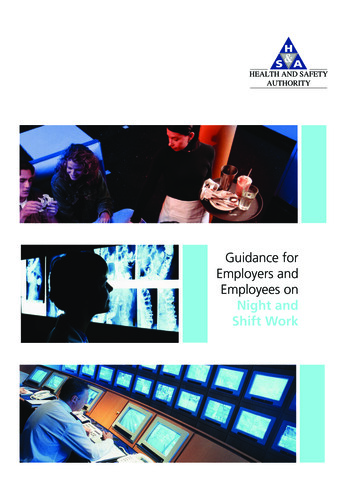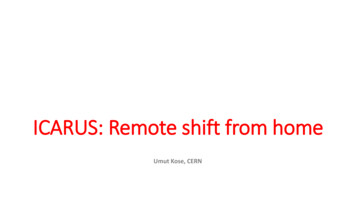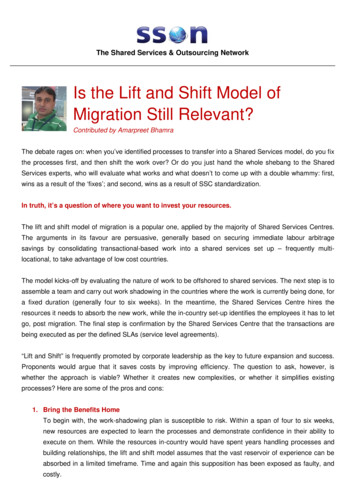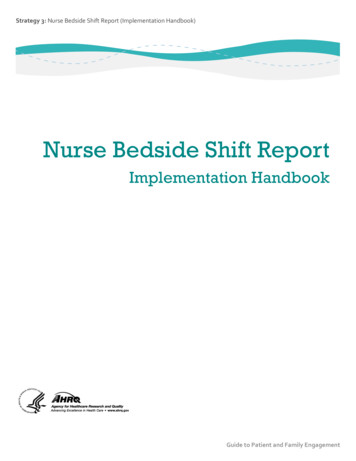
Transcription
Strategy 3: Nurse Bedside Shift Report (Implementation Handbook)Nurse Bedside Shift ReportImplementation HandbookGuide to Patient and Family Engagement
Strategy 3: Nurse Bedside Shift Report (Implementation Handbook)Table of ContentsIntroduction ----------- 1Overview of the Nurse Bedside Shift Report strategy -------------- 1What are the Nurse Bedside Shift Report tools? ---------------------2What are the resources tionale for the Nurse Bedside Shift Report Strategy ----- 3What is the evidence for nurse bedside shift report? ---------------- 3How does the Nurse Bedside Shift Report strategy facilitate bedside shift g the Nurse Bedside Shift Report Strategy --- 4Step 1: Form a multidisciplinary team to identify areas of improvement ------------------------------------------- 5Engage patients and families and unit staff in the process: Establish a multidisciplinary team ------------ 5Assess family presence or visitation policies --------------------- 5Assess current views on nurse shift changes --------------------- 5Recognize challenges in changing staff behavior -------------- 6Set aims to implement Nurse Bedside Shift ------------------- 7Step 2: Decide how to implement the Nurse Bedside Shift Report strategy ---------------------------------------8Identify the logistics of bedside shift report for your hospital -8Decide how to use and adapt the tools in this strategy -------- 9Step 3: Implement and evaluate the Nurse Bedside Shift Report strategy --------------------------------------- 10Inform staff of - 10Train staff --------- 10Conduct bedside shift report ------------------------------------- 10Assess implementation intensely during the first 2 weeks and then periodically -------------------------- 11Get feedback from nurses, patients, and families ------------- 11Refine the process ------------------------------------------------- 11Case Study on Nurse Bedside Shift Report: Emory Healthcare ------------------------------------------- 12Case Study on Nurse Bedside Shift Report: Advocate Trinity Hospital, Anne Arundel MedicalCenter, and Patewood Memorial Hospital ----------------------- 14Advocate Trinity Hospital ----------------------------------------- 15Anne Arundel Medical Center ------------------------------------ 16Patewood Memorial Hospital ------------------------------------ 17References ----------- 18Guide to Patient and Family Engagement
Strategy 3: Nurse Bedside Shift Report (Implementation Handbook)IntroductionThe Guide to Patient and Family Engagement in Hospital Quality and Safety is aresource to help hospitals develop effective partnerships with patients andfamily members with the ultimate goal of improving multiple aspects of hospitalquality and safety. *Nurse shift changes require the successful transfer of information betweennurses to prevent adverse events and medical errors. Patients and families canplay a role to make sure these transitions in care are safe and effective.Interested in improvingquality of care duringnurse shift changes?This handbook gives you an overview of and a rationale for nurse bedside shiftreport. It also provides step-by-step guidance to help you put this strategy intoplace and addresses common challenges.Read this handbook fordetailed instructions on how toadapt and implement theNurse Bedside Shift Reportstrategy at your hospital.Throughout this handbook, we have included examples and real-worldexperiences from three hospitals that implemented the Guide strategies in ayear-long pilot project: Advocate Trinity Hospital in Chicago, IL; Anne ArundelMedical Center in Annapolis, MD; and Patewood Memorial Hospital inGreenville, SC. This handbook also includes examples from Emory UniversityHospital in Atlanta, GA, a hospital that successfully implemented nurse bedsideshift report at the time the Guide was developed.Overview of the Nurse Bedside ShiftReport strategyThe goal of the Nurse Bedside Shift Report strategy is to help ensure the safehandoff of care between nurses by involving the patient and family. The patientdefines who their family is and who can take part in bedside shift report.Hospitals train nurses on how to conduct bedside shift report. On the day ofadmission, the bedside nurse or another hospital staff member briefly explainsthe process, invites the patient and family to be part of the bedside shift report,and gives the brochure on bedside shift report (see Tool 1, below) to the patient.At each shift change, shift report happens at the patient’s bedside, and thenurses invite the patient and family or friends to take part in the report.*The Guide was developed for the U.S. Department of Health and Human Services’ Agency forHealthcare Research and Quality by a collaboration of partners with experience in and commitmentto patient and family engagement, hospital quality, and safety. Led by the American Institutes forResearch, the team included the Institute for Patient and Family-Centered Care, ConsumersAdvancing Patient Safety, the Joint Commission, and the Health Research and Educational Trust.Other organizations contributing to the project included Planetree, the Maryland Patient SafetyCenter, Aurora Health Care, and Emory University Hospital.Guide to Patient and Family Engagement::1
Strategy 3: Nurse Bedside Shift Report (Implementation Handbook)What are the Nurse Bedside Shift Report tools?This section provides an overview of the tools included in this strategy.Blank cellUse this tool toDescription and formattingTool 1Nurse BedsideShift Report: Whatis it? How can youget involved?Inform the patientand family aboutwhat bedside shiftreport is and howthey can take part Given to patients on the day of admission, this handout explainswhat bedside shift report is, what patients and family or friendsshould expect, and what they need to do. It should accompany averbal explanation by bedside nurse.Tool 2Bedside ShiftReport ChecklistTrain and remindnurses of the criticalelements of bedsideshift report Made available at training and all shift changes, this checklisthighlights the six elements required to complete bedside shiftreport. As they would like, nurses can write on the form duringbedside shift report. Format: Tri-fold brochure. The electronic version of the tri-foldchecklist provides information about how to fold the brochure byindicating the front and back covers. Format: 1-page handoutTool 3Nurse BedsideShift ReportTrainingPrepare nurses toconduct bedside shiftreport Slides and talking points to train nurses to conduct a bedsideshift report and to help them understand how to engage patientsand family members in the process. Format: PowerPoint presentation with embedded videoWhat are the resources needed?Resources needed for bedside shift report will vary from hospital to hospitaldepending on the size and scope of what you want to accomplish. Staffing. Staff involved in implementing bedside shift report include time for:the point person and multidisciplinary team to identify needs and adapt thestrategy; the trainers; a registered nurse champion per shift; nurse managers,who provide support; and implementation team members who monitor andprovide feedback during shift changes for at least 2 weeks afterimplementation. Staff carry out bedside shift report as part of their regularduties. Costs. Material costs include printing of the patient and family brochure(Tool 1: Nurse Bedside Shift Report: What is it? How can you get involved?)and lamination or printing of the nurse checklist (Tool 2: Bedside Shift ReportChecklist).Guide to Patient and Family Engagement:: 2
Strategy 3: Nurse Bedside Shift Report (Implementation Handbook)Rationale for the Nurse Bedside ShiftReport StrategyPatient and family engagement creates an environment where patients, families,clinicians, and hospital staff all work together as partners to improve the qualityand safety of hospital care. Patient and family engagement encompasses behaviorsby patients, family members, clinicians, and hospital staff as well the organizationalpolicies and procedures that support these behaviors.Bedside shift report is a clinical expression of engaging patients and families asessential partners in the health care team.What is the evidence for nurse bedside shiftreport?Communication during transitions in care, such as nurse shift changes, is extremelyimportant for ensuring that the handoff is safe and effective. Allowing the patientand family to be involved in nurse bedside shift report gives them the opportunity tohear what has occurred throughout the shift and the next steps in their care. It alsogives them the chance to ask questions and provide input into the care process.Bedside shift report can improve:The three hospitals thatimplemented the Guide in ayear-long pilot project (AnneArundel Medical Center,Advocate Trinity Hospital, andPatewood Memorial Hospital)observed similar, positiveoutcomes as a result ofimplementing the bedsideshift report strategy. For moreinformation, see the casestudy at the end of thishandbook. Patient safety and quality. Bedside shift report is an opportunity to make surethere is effective communication between patients and families and nursingstaff. One study found that more than 70 percent of adverse events are causedby breakdowns in communication among caregivers and between caregivers andpatients.1 Studies have shown that bedside shift report improves patient safetyand service delivery.2,3 For example, one study showed a decrease in patient fallsduring change of shift, dropping from one to two patient falls per month to onepatient fall in six months.4Improved communication during shift report can help catch potential medicalerrors in blood incompatibility, catheter-associated urinary tract infections, andair embolism, all of which are on the Centers for Medicare and Medicaid Services’list of hospital-acquired complications “never events.” Patient experience of care. After implementing bedside shift report, hospitalsreported an increase in patient satisfaction scores and improvements in thenurse-patient relationship.5,6 Also, one study noted a sharp decline in theaverage number of call lights on by the end-of-shift change.4 Nursing staff satisfaction. Bedside shift report has improved nursing staffand physician satisfaction.2,3,6Guide to Patient and Family Engagement:: 3
Strategy 3: Nurse Bedside Shift Report (Implementation Handbook)Bedside shift report andpatient satisfactionImplementation of bedside shiftreport increased patientsatisfaction. By involving thepatients in their plan of care andkeeping all caregivers updatedon that plan, patients feel moresecure, and are more likely toparticipate in their own care andfollow recommended healthcare options.Cherri Anderson and Ruthie Mangino,Banner Desert Medical Center,6Arizona Time management and accountability between nurses. After implementingbedside shift report, nurses have reported a better ability to prioritize their workor cases during their shift and an overall decrease in staff time.4,6 One studynoted a decrease in overshift time by 100 hours in the first two pay periods on a32-bed general surgical unit.6 In another study on a 34-bed progressive care unit,a 2-month review of overtime data demonstrated an 8,000 reduction directlyassociated with the decrease in time for shift report.4How does the Nurse Bedside Shift Report strategyfacilitate bedside shift report?The Nurse Bedside Shift Report strategy identifies critical elements of bedside shiftreport and supports the patient, family, and nurse in taking part in bedside shiftreport through individual tools. The tools in this strategy: Standardize the process of nurse bedside shift report Give the patient and family an opportunity and an invitation totake part in the care Explain to the patient and family what bedside shift report is andwhat they can expect List the critical elements of bedside shift report that nurses should carry out Address common challenges and nurse concerns regarding bedside shift reportImplementing the Nurse Bedside ShiftReport StrategyThe Nurse Bedside Shift Report strategy is flexible and adaptable to each hospital’senvironment and culture. As such, this guidance provides choices and questions forhospital leaders on how to implement this strategy. It may be helpful to implementthis strategy initially on a small scale (e.g., a single unit). Identify lessons learnedfrom the single-unit pilot implementation, refine your approach, and then spread itto more units. In this way, you can build on your successes as a pathway to broaderdissemination and wider scale change.Guide to Patient and Family Engagement:: 4
Strategy 3: Nurse Bedside Shift Report (Implementation Handbook)Step 1: Form a multidisciplinary team to identifyareas of improvementAs with any new activity or quality improvement effort, planning and identifyingareas of improvement are important parts of the process. Below are some keyconsiderations as you start implementing the Nurse Bedside Shift Report strategy.Engage patients and families and unit staff in the process:Establish a multidisciplinary teamGuide ResourcesFor more information aboutworking with patient andfamily advisors, seeStrategy 1, ImplementationHandbook: Working WithPatients and Family AdvisorsThis team should include hospital leaders, nurses, key clinical and managementstaff, and patient and family advisors. Throughout the process of implementing theNurse Bedside Shift Report strategy, patient and family advisors can: Give feedback on how the current process of shift report feels Help adapt the patient and family tool (Tool 1: Nurse Bedside Shift Report:What Is It? How Can You Get Involved?) for your hospital Help adapt the standardized handoff tool (Tool 2: Bedside Shift ReportChecklist) for your hospital Take part in training nurses about bedside shift report by participating in roleplays or other small group exercises or by describing how the old and newways of shift report feel to the patient or family Observe nurses doing bedside shift report and give feedbackAssess family presence or visitation policiesGuide ResourcesFor more information aboutfamily presence policies, seeHow to Use the Guide toPatient and FamilyEngagement in Informationto Help Hospitals GetStarted.The family cannot be partners in the health care team if they are not present. It isimportant to let the patient define who their family is and that these members ofthe health care team are encouraged and supported.Assess current views on nurse shift changesUse the multidisciplinary team to review the process of shift change report and howcommunication occurs between nurses and from nurse to patient. The team canidentify what is done well and can also identify areas for improvement or possiblechallenges to implementing bedside shift report.When identifying areas for improvement, the team may want to informallyintroduce the concept of bedside shift report to nurses and hear staff nurseconcerns related to the change. In adapting the materials for your hospital, makesure to address those specific concerns.Guide to Patient and Family Engagement:: 5
Strategy 3: Nurse Bedside Shift Report (Implementation Handbook)Recognize challenges in changing staff behaviorAs with any change, some nursing staff members may be resistant to bedside shiftreports. Keep in mind that taking on new behaviors can be challenging. For all ofthese challenges, it is important to let nurses know that bedside shift report is anexpectation, not an option. Nursing leadership and management need to hold staffaccountable for conducting bedside shift report.Some examples of challenges and ways to address them are: Acknowledging the other meanings of shift report for nurses. The officialpurpose of nursing report is to transfer the accountability and responsibility ofthe patient to the nurse coming on duty. But, shift report may also serve as a wayfor nurses to connect to other staff, share emotional issues over the course of ashift, take a break from the family to focus on the patient, and socialize.7 Listento staff concerns about conducting bedside shift report and acknowledge theseother meanings of shift report. As needed, identify alternative methods oroutlets for nurses to talk with one another. Taking longer to do shift report. Although nurses may voice concerns aboutshift report taking too long, it should be quick (no more than 5 minutes). Asnoted earlier, nurses conducting bedside shift report have reported less timespent on shift report and better time management because they have seen all oftheir patients at the start of the shift and can prioritize patient needs andconcerns.4,6Advocate Trinity Hospitalsuccessfully implementedbedside shift report on a29-bed post-operativemedical-surgical unit thatincludes both private andsemiprivate rooms. Stafftrainings addressed issuesrelated to privacy andconfidentiality. Violating the Health Insurance Portability and Accountability Act(HIPAA) or patient privacy. Nurses may be concerned about violating HIPAA,especially when family members are present at shift report or if they work insemiprivate rooms. Using examples from the Office of Civil Rights’ Web site, Tool3: Nurse Bedside Shift Report Training describes how bedside shift report does notviolate HIPAA because it is part of treatment and normal operations. Dealing with sensitive information. Sometimes, the patient or family maynot be aware of certain information or a diagnosis. Bedside shift report is not anappropriate venue for discussing bad news. For example, the doctor may nothave had a chance to communicate a test result with the patient, or a mothermay not know that her son has HIV. Often, this type of sensitive informationdoes not need to be discussed at shift change. When it does, the information canbe exchanged between nurses before entering the room, or nurses can point torelevant information on the chart during the bedside shift report. To help clarifythese situations for staff nurses, your hospital may want to establish proceduresfor discussing sensitive health information, such as HIV/AIDS or hepatitis Cstatus, during bedside shift report.8Guide to Patient and Family Engagement:: 6
Strategy 3: Nurse Bedside Shift Report (Implementation Handbook)At the beginning of the pilotproject, nurses at Anne ArundelMedical Center had concernsabout bedside shift report.“I was afraid it was going to betime consuming. Whenever yougo in the room, the family is goingto ask questions, the patient isgoing to have
Tool 2. Bedside Shift Report Checklist Train and remind nurses of the critical elements of bedside shift report Made available at training and all shift changes, this checklist highlights the six elements required to complete bedsid
